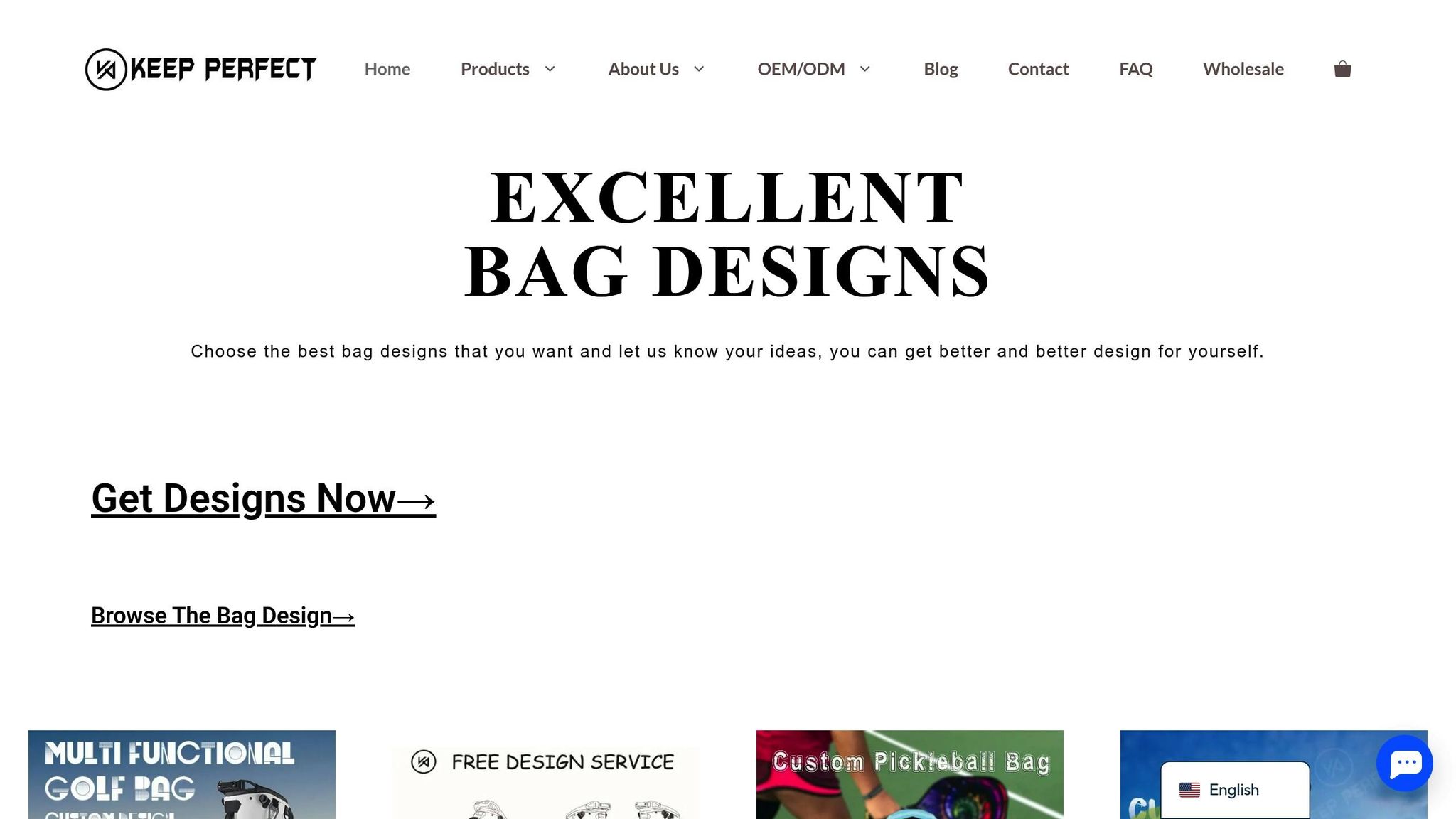Want to stand out at international trade shows? Mastering etiquette is key.
Research shows that businesses with strong etiquette practices are 3.5x more likely to succeed globally. Why? Small actions – like respecting local customs, exchanging business cards properly, or tailoring your booth design – can build trust, boost engagement, and improve lead conversion. On the flip side, ignoring these norms can cost you deals, with cultural missteps accounting for 30% of failed international negotiations.
Principais conclusões:
- Asia: Prioritize respectful gestures like two-handed business card exchanges and avoid culturally sensitive gifts.
- Europe: Punctuality and formal greetings build credibility.
- Middle East: Hospitality and acknowledging religious practices strengthen relationships.
- United States: Direct communication and quick follow-ups improve lead conversion.
For companies like SACOS DE JUNYUAN, aligning product presentations and booth strategies with local preferences has proven to increase qualified leads by up to 30%. Whether it’s multilingual materials, culturally appropriate giveaways, or staff training, attention to detail drives results.
Bottom Line: Etiquette isn’t just polite – it’s a business advantage. Prepare, train your team, and refine your approach to thrive in global markets.
15 INTERNATIONAL BUSINESS ETIQUETTE THAT COULD MAKE OR BREAK A DEAL / Import-Export Business
Key Research Findings: How Cultural Awareness Impacts Trade Show Results
Research highlights a clear connection between cultural awareness and trade show success. Companies with strong cultural intelligence are 3.5 times more likely to achieve successful international business outcomes compared to those with lower cultural intelligence. This difference underscores why understanding cultural nuances is no longer just a nice-to-have – it’s a must-have skill for businesses venturing into global markets.
Customer engagement plays a significant role, accounting for 50% of trade show performance. Exhibitors who respect and adapt to cultural norms tend to form stronger connections with attendees. These connections not only boost lead generation but also improve customer satisfaction – key metrics for trade show success.
On the flip side, communication breakdowns can be costly. Miscommunication caused by cultural misunderstandings is responsible for 30% of failed international deals. For companies that neglect cultural training, this represents a substantial loss in potential opportunities.
Cultural sensitivity also drives customer loyalty and satisfaction. Attendees are more likely to remember exhibitors who show genuine respect for their cultural backgrounds. This positive impression often translates into stronger brand associations and influences future purchasing decisions.
However, the research reveals a significant area for improvement: less than 25% of requested follow-ups are completed after trade shows. Companies that combine cultural awareness with a structured follow-up process see much better results, converting leads into business partnerships more effectively. Pairing timely follow-ups with personalized product demonstrations can further enhance these outcomes.
For custom manufacturers, cultural awareness can refine how products are presented and tailored. Booth staff who understand cultural preferences – whether it’s for specific colors, designs, or functionalities – can adapt their demonstrations to align with attendee expectations. This approach not only generates more qualified leads but also improves conversion rates.
Ultimately, these findings make one thing clear: cultural awareness isn’t just an advantage – it’s a strategic necessity. Companies that treat cultural etiquette as a core competency consistently achieve better results than those that overlook its importance.
Cultural Etiquette Practices Across Global Trade Show Regions
Grasping the nuances of regional business cultures can significantly shape the success of your trade show participation. Each region comes with its own set of expectations that influence how your company and its offerings are perceived.
Asia: Tradition Meets Business
In many Asian countries, respect, hierarchy, and strong relationships are at the heart of business culture. For instance, in China and Japan, exchanging business cards with both hands and taking a moment to review the card shows respect and signals genuine interest in building a connection. Gift-giving is another important custom, but it’s essential to choose gifts thoughtfully – avoid items like clocks or sharp objects in China, as they carry negative connotations. Communication tends to be indirect, favoring harmony, so subtlety is key. Incorporating local symbols and colors, like red for good luck in China, into your booth design can also create a more inviting atmosphere. These small gestures can pave the way for stronger business relationships.
Europe: Professionalism and Precision
European trade shows often revolve around punctuality and formality. In countries like Germany and Switzerland, being even a few minutes late can be seen as disrespectful and may harm your credibility. Professional greetings, such as a firm handshake and the use of formal titles, are standard expectations. Additionally, having multilingual materials on hand is crucial for engaging a diverse audience. These practices not only reflect professionalism but also help establish your company as reliable and respectful of cultural differences.
Middle East: Hospitality and Respect for Customs
In the Middle East, building relationships and showing hospitality are central to business interactions. Meetings often start with the offering of tea or coffee, and accepting this gesture is a sign of respect. Business discussions typically follow after these social pleasantries, allowing rapport to develop naturally. It’s also important to acknowledge religious customs, such as prayer times and dietary restrictions, especially during Ramadan. Providing private meeting spaces and offering refreshments that align with local preferences can demonstrate your understanding of these cultural norms.
United States: Efficiency and Directness
Trade shows in the United States focus on time management, direct communication, and concise presentations. Exhibitors are expected to be proactive and get straight to the point, as attendees often have packed schedules. Clear messaging, interactive displays, and branded giveaways can quickly grab attention. Additionally, following up promptly after the event is crucial for turning leads into lasting business relationships.
| Region | Key Practices | Impact |
|---|---|---|
| Asia | Gift-giving, formal card exchanges, indirect communication | Builds trust and long-term partnerships |
| Europe | Punctuality, formal greetings, multilingual materials | Shows professionalism and reliability |
| Middle East | Hospitality, respect for religious customs, social pleasantries | Strengthens trust and avoids cultural missteps |
| United States | Direct communication, time efficiency, prompt follow-up | Boosts productivity and lead conversion |
Research indicates that companies that adapt their approach to include culturally appropriate greetings and follow-ups can see up to 30% more qualified leads at international trade shows. These insights are invaluable for crafting region-specific strategies that resonate with your audience.
sbb-itb-1e6451b
Practical Strategies for Exhibitors to Apply Cultural Etiquette
Making cultural etiquette a priority at trade shows requires thoughtful planning and preparation. Businesses that embrace this approach are better equipped to build meaningful connections and achieve stronger results.
Conduct Pre-Event Research
Preparation is key to aligning with local customs. Begin researching cultural practices at least 4-6 weeks before the event to allow enough time for training and adjustments.
Start by learning about greeting customs, business card exchanges, and gift-giving traditions, as these are often the first points of contact. Missteps in these areas can leave a negative impression and jeopardize potential partnerships.
Dive deeper into gift-giving norms, including what types of gifts are appropriate, how they should be presented, and items to avoid. For example, certain colors, numbers, or objects may carry negative connotations in specific cultures, making it essential to get these details right.
Additionally, study communication styles and decision-making preferences. In some regions, relationship-building comes before business discussions, while others favor a more direct, transaction-oriented approach. Knowing whether to prioritize harmony or straightforward dialogue can help you connect more effectively.
Don’t forget to factor in religious practices, holiday schedules, and local taboos. Being mindful of prayer times, dietary restrictions, and cultural sensitivities shows respect and avoids unintended offenses that could strain relationships.
This research lays the foundation for training your team to navigate these nuances effectively.
Train Booth Staff in Cross-Cultural Communication
Your booth staff plays a central role in representing your company, so equipping them with cultural knowledge is essential. Cultural awareness training can have a measurable impact on your success.
Teach your team to approach every visitor with equal respect, regardless of their appearance or background. Misjudging attendees can lead to missed opportunities.
Focus on understanding communication styles, including proper greetings, non-verbal cues, and the role of hierarchy in interactions. Role-playing exercises are especially helpful in preparing staff to handle diverse scenarios with confidence.
Encourage your team to maintain a positive and welcoming attitude throughout the event. Enthusiasm and energy create an inviting atmosphere that resonates across cultural boundaries. Make it a priority for staff to greet every visitor, as ignoring attendees is a universal turn-off.
Provide basic language tips and cultural overviews for your target audience. Even knowing a few polite phrases in the local language can demonstrate effort and respect, leaving a lasting impression.
With these tools, your team will be well-equipped to handle cross-cultural interactions with professionalism and warmth.
Adapt Booth Design and Materials
Tailoring your booth and materials to the audience shows thoughtfulness and helps bridge cultural gaps.
Start by creating multilingual marketing materials to make your content accessible to attendees from various linguistic backgrounds. This small step removes barriers and signals your commitment to connecting with international markets.
Next, adapt your booth’s look and feel. Incorporate design elements that resonate with local preferences, such as culturally significant colors or visual themes. For instance, a brand like JUNYUAN BAGS might highlight products tailored to local needs, such as sacos ecológicos for European attendees or durable travel options for frequent flyers in Asia.
Make your booth memorable by incorporating creative elements that engage visitors. Adding touches that reflect local traditions while staying true to your brand can leave a lasting impression.
Choose giveaways that are both practical and culturally appropriate. These items should be useful on the show floor and align with local customs. The goal is to provide value while respecting cultural norms.
Lastly, consider how your booth layout can accommodate cultural differences. Some cultures value personal space, while others prefer closer interactions. Design your space to make all visitors feel comfortable, no matter their preferences.
| Research Focus | Key Elements | Timeline |
|---|---|---|
| Communication Protocols | Greeting styles, business card exchange, conversation topics | 4-6 weeks before event |
| Cultural Sensitivities | Religious customs, taboos, gift-giving practices | 4-6 weeks before event |
| Staff Training | Cross-cultural communication, role-playing scenarios | 2-3 weeks before event |
| Material Adaptation | Multilingual content, culturally appropriate designs | 3-4 weeks before event |
Investing time and effort into cultural preparation not only strengthens relationships but also opens doors to new opportunities. Businesses that adapt to cultural differences are poised to thrive in global markets and foster lasting partnerships.
Como SACOS DE JUNYUAN Can Use Cultural Etiquette for Custom Bag Success

JUNYUAN BAGS has successfully incorporated cultural etiquette into its product customization and trade show strategies, using its years of expertise to connect with diverse international markets. This thoughtful approach helps the company create designs and presentations that resonate with local preferences while showcasing its adaptability.
Tailoring Designs to Local Preferences
Understanding and respecting cultural preferences is key. For instance, in Japan, designs with subtle elegance and respectful, two-handed demonstrations foster trust. In Middle Eastern markets, culturally appropriate colors and modest styles are essential. Meanwhile, U.S. consumers often prefer larger travel bags, while compact, multi-functional designs appeal to urban shoppers in Europe.
Collaborating Through OEM/ODM Services
By partnering with local experts, JUNYUAN BAGS ensures that its designs reflect authentic cultural insights. These collaborations not only enhance product relevance but also strengthen relationships with regional partners.
Creating Engaging Booth Presentations
At trade shows, culturally aligned imagery and multilingual signage make a lasting impression. A 2023 report by Brand Fuel revealed that live personalization and culturally themed giveaways led to a 30% increase in qualified leads. JUNYUAN BAGS brings this concept to life by offering on-site customization demonstrations, where its design team adapts logos, patterns, and materials in real time to reflect local tastes. This interactive experience highlights the company’s versatility and commitment to meeting individual preferences.
Focusing on Regional Interests
The company’s wide product range allows it to emphasize features that meet specific regional needs. By showcasing practical design elements that align with local lifestyles, JUNYUAN BAGS demonstrates its dedication to understanding and addressing customer priorities.
Thoughtful Gift-Giving Strategies
Promotional items designed with local themes provide memorable takeaways that respect cultural norms while highlighting product quality. These gifts not only leave a positive impression but also reinforce the company’s cultural awareness.
Conclusion: The Role of Cultural Etiquette in Trade Show Excellence
Understanding and respecting cultural etiquette has become a key factor for success in international trade shows. Companies that prioritize cultural awareness often see stronger relationships, better market penetration, and higher profits. On the other hand, neglecting these norms can lead to miscommunication, strained relationships, and missed opportunities.
Research shows that businesses with a cultural edge consistently outperform their competitors. By making a positive first impression and nurturing meaningful partnerships, these companies gain a significant advantage. For example, exhibitors like JUNYUAN BAGS have reaped clear rewards, such as improved customer engagement, stronger brand reputation, and higher conversion rates when presenting their customizable products to diverse global audiences.
The importance of cultural etiquette cannot be overstated. Ignoring it can undermine even the best products or services. Practical steps like conducting thorough pre-event research and training booth staff in cross-cultural communication offer a clear path to success. Without these efforts, businesses risk falling short in competitive international markets.
As trade show formats evolve, with virtual and hybrid events becoming more common, maintaining cultural sensitivity in digital interactions will be an added challenge. Future studies should examine how traditional etiquette principles translate to virtual settings, including online greetings, networking, and communication protocols.
Cultural etiquette isn’t just a nice-to-have – it’s a strategic tool for global success. Investing in cultural training pays off not only during trade shows but throughout the entire customer journey. JUNYUAN BAGS’ results highlight how tailored approaches to cultural sensitivity can deliver universal benefits. As global business continues to grow, those who embrace and master cultural etiquette will be better equipped to build lasting partnerships and achieve sustainable success in diverse markets.
FAQs
How can businesses train their staff in cultural etiquette to succeed at international trade shows?
Training your staff in etiquette for different cultures plays a key role in forming meaningful connections and thriving at international trade shows. A great way to start is by organizing workshops on cultural awareness. These sessions can cover essential topics like local customs, communication preferences, and business practices specific to your target audience. Adding role-playing exercises and case studies can make the training more practical, helping your team handle real-world interactions with confidence.
Another effective approach is to provide resources such as cultural guides or collaborate with professionals who can deliver customized training. These tools ensure your employees are ready to connect with people from diverse backgrounds. With the right preparation, your team can create a warm, professional atmosphere that resonates with international clients.
What cultural etiquette should businesses understand to succeed at international trade shows?
Understanding and respecting etiquette is a game-changer when it comes to making a good impression at international trade shows. It’s not just about showing up; it’s about showing you care enough to understand the local customs. Here are some key areas to focus on:
- Greetings and Introductions: In some regions, a firm handshake is the norm; in others, a respectful bow or even a light kiss on the cheek might be expected. Knowing the preferred greeting style can set the tone for a positive interaction.
- Business Card Etiquette: Don’t underestimate the importance of how you handle a business card. In many places, it’s more than just an exchange of contact details – it’s a sign of respect. Always take a moment to examine the card before putting it away, and present yours with care.
- Communication Style: Cultures differ in how they communicate. Some value a direct, no-frills approach, while others lean toward more indirect and polite exchanges. Understanding this can help you navigate conversations with ease.
Taking the time to research and practice these customs can go a long way in building trust and forming genuine connections with potential clients and partners. It’s not just about doing business; it’s about showing respect.
How does understanding cultural etiquette impact success at international trade shows?
Understanding and respecting the etiquette of different cultures can make a huge difference when participating in international trade shows. It’s about more than just good manners – it’s about building trust, forming stronger connections, and leaving a lasting impression on potential clients or partners from diverse backgrounds. Simple things like knowing the appropriate way to greet someone, following local business customs, or adapting your communication style can make conversations flow more smoothly and productively.
When you show that you’re mindful of cultural nuances, you’re not just being polite – you’re increasing your chances of turning leads into long-term customers. This kind of awareness can spark meaningful interactions, boost engagement, and position your brand as professional and considerate in the global arena.




 Telemóvel/What's App/Wechat
Telemóvel/What's App/Wechat E-Mail
E-Mail ADD
ADD




